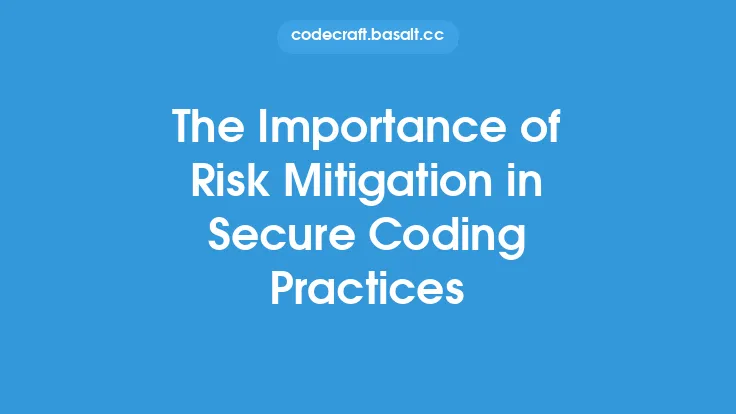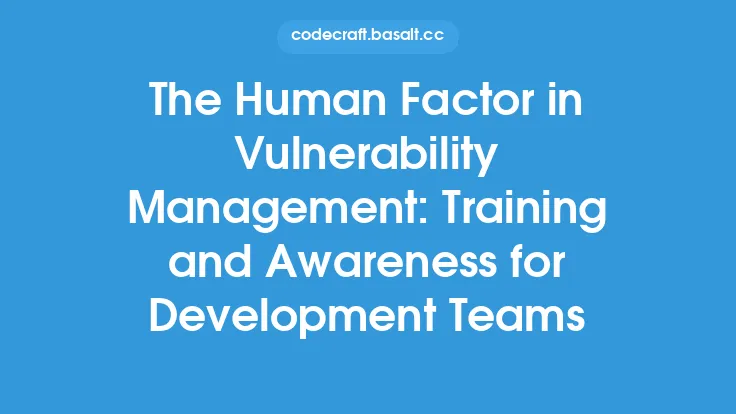Security awareness is a critical aspect of cybersecurity that involves educating individuals about the potential risks and threats associated with software development and usage. As technology advances and software becomes increasingly complex, the need for secure coding practices has never been more pressing. In this article, we will delve into the world of security awareness and secure coding practices, providing a comprehensive guide for developers, organizations, and individuals looking to improve their cybersecurity posture.
Introduction to Secure Coding Practices
Secure coding practices are a set of guidelines and principles that developers can follow to ensure that their code is secure, reliable, and resistant to vulnerabilities. These practices involve a combination of technical skills, knowledge, and mindset, and are essential for preventing common web application vulnerabilities such as SQL injection, cross-site scripting (XSS), and cross-site request forgery (CSRF). By following secure coding practices, developers can reduce the risk of security breaches, protect sensitive data, and ensure the integrity of their software.
Understanding Common Web Application Vulnerabilities
Web application vulnerabilities are a major concern for organizations and individuals alike. These vulnerabilities can be exploited by attackers to gain unauthorized access to sensitive data, disrupt service, or take control of entire systems. Some of the most common web application vulnerabilities include:
- SQL injection: This occurs when an attacker injects malicious SQL code into a web application's database, allowing them to access, modify, or delete sensitive data.
- Cross-site scripting (XSS): This occurs when an attacker injects malicious code into a web application, allowing them to steal user data, take control of user sessions, or perform other malicious activities.
- Cross-site request forgery (CSRF): This occurs when an attacker tricks a user into performing an unintended action on a web application, allowing them to gain unauthorized access to sensitive data or disrupt service.
- Buffer overflow: This occurs when an attacker sends more data to a web application than it is designed to handle, allowing them to execute malicious code or crash the system.
Secure Coding Principles
Secure coding principles are a set of guidelines that developers can follow to ensure that their code is secure and resistant to vulnerabilities. Some of the most important secure coding principles include:
- Input validation: This involves validating all user input to ensure that it is correct and secure.
- Error handling: This involves handling errors and exceptions in a secure and reliable manner.
- Secure data storage: This involves storing sensitive data in a secure and encrypted manner.
- Secure communication: This involves using secure communication protocols such as HTTPS to protect data in transit.
- Secure authentication and authorization: This involves using secure authentication and authorization mechanisms to control access to sensitive data and systems.
Secure Coding Techniques
Secure coding techniques are a set of methods and tools that developers can use to implement secure coding principles. Some of the most important secure coding techniques include:
- Code reviews: This involves reviewing code to identify vulnerabilities and ensure that it is secure and reliable.
- Static analysis: This involves using automated tools to analyze code for vulnerabilities and security risks.
- Dynamic analysis: This involves using automated tools to analyze code while it is running, to identify vulnerabilities and security risks.
- Penetration testing: This involves simulating attacks on a web application to identify vulnerabilities and security risks.
- Secure coding frameworks: This involves using frameworks and libraries that provide secure coding functionality, such as encryption and authentication.
Best Practices for Secure Coding
Best practices for secure coding involve a combination of technical skills, knowledge, and mindset. Some of the most important best practices for secure coding include:
- Following secure coding principles and guidelines
- Using secure coding techniques and tools
- Participating in code reviews and static analysis
- Staying up-to-date with the latest security threats and vulnerabilities
- Using secure coding frameworks and libraries
- Implementing secure authentication and authorization mechanisms
- Using secure communication protocols such as HTTPS
Security Awareness and Training
Security awareness and training are critical components of a comprehensive cybersecurity strategy. Security awareness involves educating individuals about the potential risks and threats associated with software development and usage, while security training involves providing individuals with the skills and knowledge they need to implement secure coding practices. Some of the most important security awareness and training topics include:
- Common web application vulnerabilities and how to prevent them
- Secure coding principles and guidelines
- Secure coding techniques and tools
- Best practices for secure coding
- Security threats and vulnerabilities
- Secure communication protocols and data storage
Conclusion
Security awareness and secure coding practices are critical components of a comprehensive cybersecurity strategy. By following secure coding principles, using secure coding techniques, and participating in security awareness and training, developers and organizations can reduce the risk of security breaches, protect sensitive data, and ensure the integrity of their software. As technology advances and software becomes increasingly complex, the need for secure coding practices has never been more pressing. By prioritizing security awareness and secure coding practices, we can create a safer and more secure digital landscape for everyone.





